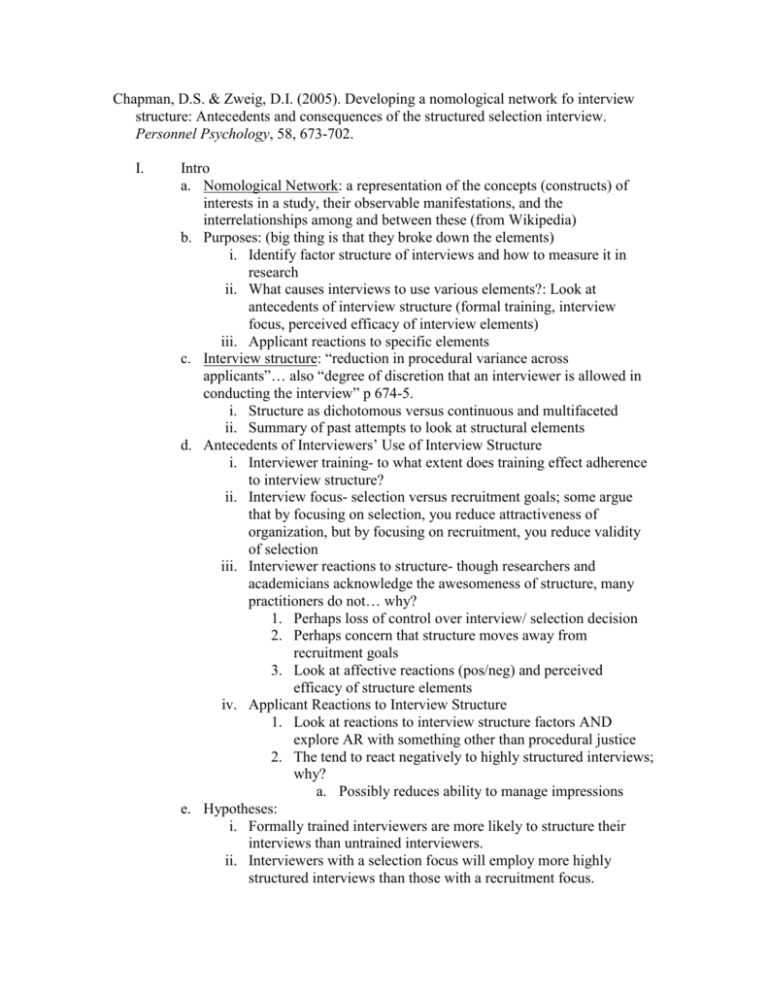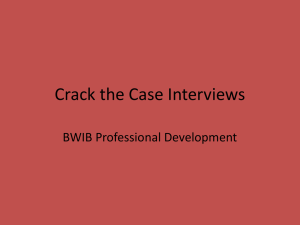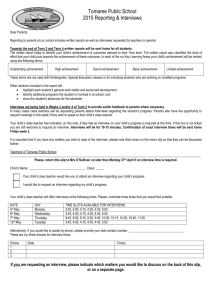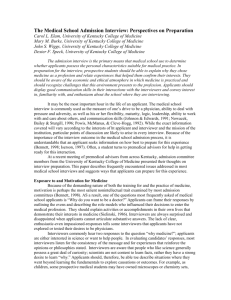Chapman & Zweig 2005
advertisement

Chapman, D.S. & Zweig, D.I. (2005). Developing a nomological network fo interview structure: Antecedents and consequences of the structured selection interview. Personnel Psychology, 58, 673-702. I. Intro a. Nomological Network: a representation of the concepts (constructs) of interests in a study, their observable manifestations, and the interrelationships among and between these (from Wikipedia) b. Purposes: (big thing is that they broke down the elements) i. Identify factor structure of interviews and how to measure it in research ii. What causes interviews to use various elements?: Look at antecedents of interview structure (formal training, interview focus, perceived efficacy of interview elements) iii. Applicant reactions to specific elements c. Interview structure: “reduction in procedural variance across applicants”… also “degree of discretion that an interviewer is allowed in conducting the interview” p 674-5. i. Structure as dichotomous versus continuous and multifaceted ii. Summary of past attempts to look at structural elements d. Antecedents of Interviewers’ Use of Interview Structure i. Interviewer training- to what extent does training effect adherence to interview structure? ii. Interview focus- selection versus recruitment goals; some argue that by focusing on selection, you reduce attractiveness of organization, but by focusing on recruitment, you reduce validity of selection iii. Interviewer reactions to structure- though researchers and academicians acknowledge the awesomeness of structure, many practitioners do not… why? 1. Perhaps loss of control over interview/ selection decision 2. Perhaps concern that structure moves away from recruitment goals 3. Look at affective reactions (pos/neg) and perceived efficacy of structure elements iv. Applicant Reactions to Interview Structure 1. Look at reactions to interview structure factors AND explore AR with something other than procedural justice 2. The tend to react negatively to highly structured interviews; why? a. Possibly reduces ability to manage impressions e. Hypotheses: i. Formally trained interviewers are more likely to structure their interviews than untrained interviewers. ii. Interviewers with a selection focus will employ more highly structured interviews than those with a recruitment focus. II. III. iii. Interviewers will report more positive affective reactions to their interviews when they are less structured. iv. Interviewers employing higher levels of interview structure will perceive interviews to be a) better selecting tools, and b) worse recruiting tools than lower levels of structure. v. Applicants will react negatively to higher levels of structure 1. more negative procedural justice 2. greater difficulty with the interview 3. lower intentions to accept a job offer Method a. Face2face interviews of 812 applicants and 428 interviewers; sample B was 164 more interviewers b. Measured structural elements with a 16-item scale, then self-report of training, interview focus, interviewer reactions (pos/neg); applicantprocedural justice, perceived difficulty, post-interview intentions (likelihood of accepting an offer) Results a. Factors: CFA from 2 samples concluded 4 categories: Question consistency (same questions, same order, every candidate), evaluation standardization (using standardized and numeric scoring), question sophistication (using valid question content like situational and behavioral questions), and rapport building (not job-related, asking about hobbies, light convo) i. Question sophistication and rapport building were lower reliabilities: why? Perhaps because less variability in use (ex. ask only one kind of rapport building question OR ask only behavioral questions and not situational) b. Training: Interviewers who received formal training were more likely to use higher levels of structure in their interviews i. Specifically on Evaluation standardization and question sophistication and consistency (B); rapport building not affected; H1 supported c. Focus: (recruit or select?) somewhat related to evaluation standardization and question consistency (positive relationships, aka, the more X, the closer focus was to selection). H2 partially supported d. Interviewer Affective Reactions: positive prediction for both Question sophistication and Rapport building (the more X = more positive affect) i. It is unexpected that this happened for qSophistication! e. Perceptions of Selections and Recruitment efficacy: i. no relationship for selection efficacy ii. for recruitment efficacy: high rapport building (low structure) and high question sophistication=high recruitment efficacy; iii. People who said they had more of a selection focus reported lower selection efficacy!!! Weird!? f. Training and efficacy: people with more training thought their interviews had more recruitment efficacy than untrained interviewers IV. g. Campion’s research: better questions, anchored rating scales, discouraging applicant questions X positive interviewer reactions h. Applicant reactions (AR)- Procedural justice: no relationship b/w justice and structure i. AR difficulty: more structure=more difficult j. Acceptance intentions: no effect for structure k. Campion’s AR: discouraging questions and multiple interviewers = less fair; selection focus=less likely to accept an offer Discussion a. Though high rapport building = low structure, even trained interviewers insist on using it; it could contaminate data, however we are still human beings! b. Why would question sophistication be associated with perceived recruitment efficacy? Maybe you want to portray your organization in a professional light. (applicants don’t feel the same way; it has no effect on accepting the job) c. Overall interviewers were confident that they could identify the best applicants regardless of amount of structure (no battle between selection vs recruitment)






